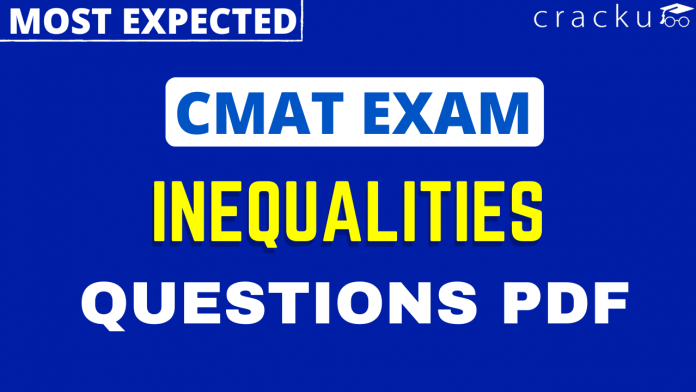Inequalities is one of the most important topics in the CMAT, and also it is an important section. One can utilize this article which consists of the most important questions regarding Inequalities. Cracku provides you with the Top 20 very Important Inequalities Questions for CMAT based on the questions asked in previous exam papers. Click on the link below to download the Inequalities Questions for CMAT PDF with detailed answers.
Download Inequalities Questions for CMAT
Enroll to CMAT 2023 Crash Course
Instructions
For each of the following five questions, the prices of various items are shown by inequalities. The statement in each question is followed by 2 conclusions. Based on the information in the statement, which of the conclusions are implied?
Question 1: Statement $ Ketch up > Iodised salt \geq Tomatoes \geq Eggs $ and Oranges < Radish < Ketch up
Conclusions 1) Radish < eggs 2) Oranges < Tomatoes
a) Neither of the conclusion is implied.
b) Conclusion 2 is implied but conclusion 1 is not
c) Conclusion 1 is implied but conclusion 2 is not
d) Both the conclusions are implied.
e) Either conclusion 1 or conclusion 2 is implied but both are not.
1) Answer (A)
Solution:
Statement $ Ketch up > Iodised salt \geq Tomatoes \geq Eggs $ and Oranges < Radish < Ketch up
=> $ oranges < radish < ketchup> iodized salt \geq tomatoes \geq eggs $
As there is no direct relation between oranges and tomatoes and between radishes and eggs, we cannot conclude either of the conclusions.
So, both the conclusions are false.
Question 2: Cat < Lion < Ostrich = Otter = Dove $ \geq $ Salmon > Yak
Conclusions 1) Ostrich > Yak 2) Cat < Dove
a) Neither of the conclusion is implied.
b) Conclusion 2 is implied but conclusion 1 is not
c) Conclusion 1 is implied but conclusion 2 is not
d) Both the conclusions are implied.
e) Either conclusion 1 or conclusion 2 is implied but both are not.
2) Answer (D)
Solution:
Cat < Lion < Ostrich = Otter = Dove $ \geq $ Salmon > Yak
Hence, Ostrich > Yak and Cat < Dove.
So, both the conclusions are implied.
Question 3: $ Ketchup \geq Lemons > Mango \geq Neem $
Conclusions 1) $ Neem \leq Ketch up $2) Neem < Ketchup
a) Neither of the conclusion is implied.
b) Conclusion 2 is implied but conclusion 1 is not
c) Conclusion 1 is implied but conclusion 2 is not
d) Both the conclusions are implied.
e) Either conclusion 1 or conclusion 2 is implied but both are not.
3) Answer (B)
Solution:
$ Ketchup \geq Lemons > Mango \geq Neem $
Hence, Ketchup > Neem
So, conclusion 2 is implied.
Question 4: $ zebra \geq yak = whale \leq xray $
conclusions 1) whale < zebra 2) whale = zebra
a) Neither of the conclusion is implied.
b) Conclusion 2 is implied but conclusion 1 is not
c) Conclusion 1 is implied but conclusion 2 is not
d) Both the conclusions are implied.
e) Either conclusion 1 or conclusion 2 is implied but both are not.
4) Answer (E)
Solution:
$ zebra \geq yak = whale \leq xray $
Hence, $ whale \leq zebra $ => whale = zebra or whale < zebra
So, either of the two conclusions are implied.
Question 5: Banana> apple> salmon, carrot > lemon > yak milk
conclusions 1) banana > lemon 2) apple > yak milk
a) Neither of the conclusion is implied.
b) Conclusion 2 is implied but conclusion 1 is not
c) Conclusion 1 is implied but conclusion 2 is not
d) Both the conclusions are implied.
e) Either conclusion 1 or conclusion 2 is implied but both are not.
5) Answer (A)
Solution:
Banana> apple> salmon and carrot > lemon > yak milk
As there is not direct link between the two, neither of the conclusions is implied.
Instructions
In these questions, relationships between different elements is shown in the statements. The statements is followed by two conclusions. Study the conclusions based on the given statement and select the appropriate answer.
Question 6: Statement: K > I $ \geq $ T $ \geq $ E; O < R < K
Conclusions: I. R < E 2. O < T
a) Neither conclusion I nor II follows
b) Both conclusions I and II follows
c) Only conclusion II follows
d) Either conclusion I or II follows
e) Only conclusion I follows
6) Answer (A)
Solution:
According to the given inequalities, K is largest among all but nothing specific can be said about O,R,I,T and E. Hence, no conclusion can be drawn from the given information. So answer will be A
Question 7: Statement C < L < O = U = D $ \geq $ S > Y
Conclusions I. O > Y II. C<D
a) Neither conclusion I nor II follows
b) Both conclusions I and II follows
c) Only conclusion I follows
d) Either conclusion II follows
e) Only conclusion I or II follows
7) Answer (B)
Solution:
As it is given in statement 1 that O=U=D which is greater than S, Y, L and C hence, the conclusions O>Y and C<D can drawn from the given statements.
Hence, answer will be B
Question 8: Statement K $ \geq $ L > M $ \geq $ N
Conclusions I. N $ \leq $ K II. N<K
a) Both conclusions I and II follows
b) Neither conclusion I nor II follows
c) Either conclusion II or II follows
d) Only conclusion I follows
e) Only conclusion II follows
8) Answer (E)
Solution:
In conclusion 1, it is given that N<=K. That’s not possible as N is less than or equal to M which is absolutely less than K. Conclusion 2 is valid as it mentions that N < K. Hence, only conclusion 2 will follow.
Question 9: Statement: Z $ \geq $ Y = W $ \geq $ X
Conclusions I. W<Z II. W=Z
a) Only conclusion II follows
b) Only conclusion I follows
c) Neither conclusion I nor II follows
d) Either conclusion I or II follows
e) Both conclusions I and II follows
9) Answer (D)
Solution:
According to the given statement Z>= Y and Y=W So Z>=W
Hence, anyone of the conclusion might be followed. Hence, answer will be D
Question 10: Statement: B > A > S < I > C > L >Y
Conclusions I. B>L II. A>Y
a) Only conclusion I follows
b) Only conclusion II follows
c) Either conclusion II or II follows
d) Neither conclusion I nor II follows
e) Both conclusions I and II follows
10) Answer (D)
Solution:
According to the given inequalities, nothing certain can be said about B, L and A, Y as no absolute measurement can be drawn from the given inequalities. Hence, answer will be D
Instructions
In these questions, the relationship between different elements is shown in the statements. The statements are followed by two conclusions. Give answer
Question 11: Statements: $F < R\geq O=M\leq T=K$
Conclusions: I. $K\geq O$
II.F < M
a) if only conclusion I is true
b) if only conclusion II is true
c) if either conclusion I or II is true
d) if neither conclusion I nor II is true
e) if both conclusion I and II are true
11) Answer (A)
Solution:
T is greater than or equal to M. But T is equal to K. K is greater than or equal to M. O is equal to M.
Therefore, K is greater than or equal to O.
Hence, conclusion I follows.
We cannot establish a relation between F and M even both are known to be less than F.
Hence, this conclusion II does not follow.
Option A is correct.
Question 12: Statements: $G=N\leq O\geq P>Q=R$
Conclusions: I. O >R
II. $P\leq G$
a) if only conclusion I is true
b) if only conclusion II is true
c) if either conclusion I or II is true
d) if neither conclusion I nor II is true
e) if both conclusion I and II are true
12) Answer (A)
Solution:
I. O >R. This is a correct coclusion because Q is greater than R. P is greater than Q while I is greater than or equal to R. Hence, O is greater than R.
II. $P\leq G$. We cannot draw any conclusion between relationship of P with G.
Only conclusion I follows.
Question 13: Statements: $F<O=L\geq W=S$
Conclusions: I. $W\leq F$
II. $O\geq S$
a) if only conclusion I is true
b) if only conclusion II is true
c) if either conclusion I or II is true
d) if neither conclusion I nor II is true
e) if both conclusion I and II are true
13) Answer (B)
Solution:
No relation can be established between W and F as data provided is inadequate.
L is greater than W. O is equal to L. Therfore, O is greater than W. W is equal to S.
Hence, we can say that, O is greater than S.
Option B is correct option.
Question 14: Statements: $B=R\geq T<O=P\geq S$
Conclusions: I. B < O
II. T < S
a) if only conclusion I is true
b) if only conclusion II is true
c) if either conclusion I or II is true
d) if neither conclusion I nor II is true
e) if both conclusion I and II are true
14) Answer (D)
Solution:
Conclusions:
I. B < O, we cannot establish any direct relationship between B and O as no such data is provided.
II. T < S, no relationship can be established between T and S as data provided is inadequate.
Hence, conclusions I and II do not follow.
Therefore, option D is correct.
Question 15: Statements: $P>Q\geq A<R=I$
Conclusions:
I. A < P
II. I > A
a) if only conclusion I is true
b) if only conclusion II is true
c) if either conclusion I or II is true
d) if neither conclusion I nor II is true
e) if both conclusion I and II are true
15) Answer (E)
Solution:
P is greater than Q which is greater than or equal to R. Hence, we can say that P is greater than R.
Hence, conclusion I follows.
R is greater than A but I and A are equal. Therefore, R is greater than I.
Hence, conclusion II follows.
Both I and II follow.
Option E is correct.
Instructions
<p “=””>In each of the following questions, relationship between different elements is shown in the statements. The statements are followed by two conclusions numbered I and II. Study the conclusions based on the given statements and select the appropriate answer.
Give answer (a) if only Conclusion I is true
Give answer (b) if neither Conclusion I nor Conclusion II is true
Give answer (c) if only Conclusion II is true
Give answer (d) if both Conclusion I and Conclusion II are true
Give answer (e) if either Conclusion I or Conclusion II is true
Question 16: Statements
M > A ≥ B = Q ≤ P < J ≤ Y = Z ≥ A > X
Conclusions:
I. B < Y
II. X ≥ J
a) if only Conclusion I is true
b) if neither Conclusion I nor Conclusion II is true
c) if only Conclusion II is true
d) if both Conclusion I and Conclusion II are true
e) if either Conclusion I or Conclusion II is true
16) Answer (A)
Solution:
Statement : M > A ≥ B = Q ≤ P < J ≤ Y = Z ≥ A > X
Conclusions:
I. B < Y : true
II. X ≥ J : false
Thus, only Conclusion I is true.
=> Ans – (A)
Question 17: Statements
M > A ≥ B = Q ≤ P < J ≤ Y = Z ≥ A > X
Conclusions
I. Z = Q
II. Z > Q
a) if only Conclusion I is true
b) if neither Conclusion I nor Conclusion II is true
c) if only Conclusion II is true
d) if both Conclusion I and Conclusion II are true
e) if either Conclusion I or Conclusion II is true
17) Answer (C)
Solution:
Statement : M > A ≥ B = Q ≤ P < J ≤ Y = Z ≥ A > X
Conclusions :
I. Z = Q : It cannot be true as J > P
II. Z > Q : It is true
Thus, only conclusion II is true.
Hence, option C is the correct answer.
Question 18: Statements
G < R = A ≤ S ; T < R
Conclusions
I. G < S
II. S > T
a) if only Conclusion I is true
b) if neither Conclusion I nor Conclusion II is true
c) if only Conclusion II is true
d) if both Conclusion I and Conclusion II are true
e) if either Conclusion I or Conclusion II is true
18) Answer (D)
Solution:
Statements : G < R = A ≤ S ; T < R
=> $S\geq R>G$ and $R>T$
Conclusions :
I. G < S = true
II. S > T = true
Thus, both Conclusion I and Conclusion II are true.
=> Ans – (D)
Question 19: Statements
P = U < M < K ≤ I > N ; D ≥ P ; I ≥ C
Conclusions
I. M < C
II. N > U
a) if only Conclusion I is true
b) if neither Conclusion I nor Conclusion II is true
c) if only Conclusion II is true
d) if both Conclusion I and Conclusion II are true
e) if either Conclusion I or Conclusion II is true
19) Answer (B)
Solution:
Statements : P = U < M < K ≤ I > N ; D ≥ P ; I ≥ C
Conclusions :
I. M < C = false
II. N > U = false
Thus, neither Conclusion I nor Conclusion II is true.
=> Ans – (B)
Question 20: Statements
P = U < M < K ≤ I > N ; D ≥ P ; I ≥ C
Conclusions
I. D ≥ K
II. I > P
a) if only Conclusion I is true
b) if neither Conclusion I nor Conclusion II is true
c) if only Conclusion II is true
d) if both Conclusion I and Conclusion II are true
e) if either Conclusion I or Conclusion II is true
20) Answer (C)
Solution:
Statements : P = U < M < K ≤ I > N ; D ≥ P ; I ≥ C
Conclusions :
I. D ≥ K = false
II. I > P = true
Thus, only Conclusion II is true
=> Ans – (C)





